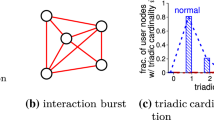Abstract
Evolutionary behavior of Online Social Networks (OSNs) has not been well understood in many different aspects. Although there have been many developments around social applications like recommendation, prediction, detection and identification which take advantage of past observations of structural patterns, they lack the necessary representative power to adequately account for the sophistication contained within relationships between actors of a social network in real life. In this demo, we extend the innovative developments of SLIND [17] (Stable LINk Detection) to include a novel generative adversarial architecture and the Relational Turbulence Model (RTM) [15] using relational features extracted from real-time twitter streaming data. Test results show that SLIND\(^+\) is capable of detecting relational turbulence profiles learned from prior feature evolutionary patterns in the social data stream. Representing turbulence profiles as a pivotal set of relational features improves detection accuracy and performance of well-known application approaches in this area of research.
Access this chapter
Tax calculation will be finalised at checkout
Purchases are for personal use only
Similar content being viewed by others
References
Backstrom, L., Leskovec, J.: Link prediction in social networks using computationally efficient topological features. In: 2011 IEEE Third International Conference on Privacy, Security, Risk and Trust (PASSAT) and 2011 IEEE Third Inernational Conference on Social Computing (SocialCom), pp. 73–80. IEEE (2011)
Choi, E., et al.: Multi-layer representation learning for medical concepts. In: Proceedings of the 22nd ACM SIGKDD International Conference on Knowledge Discovery and Data Mining, pp. 1495–1504. ACM (2016)
Cordeiro, M., Gama, J.: Online social networks event detection: a survey. In: Michaelis, S., Piatkowski, N., Stolpe, M. (eds.) Solving Large Scale Learning Tasks. Challenges and Algorithms. LNCS (LNAI), vol. 9580, pp. 1–41. Springer, Cham (2016). https://doi.org/10.1007/978-3-319-41706-6_1
Deng, L., Yu, D., et al.: Deep learning: methods and applications. Found. Trends® Signal Process. 7(3–4), 197–387 (2014)
Ding, Y., Liu, C., Zhao, P., Hoi, S.C.H.: Large scale kernel methods for online AUC maximization. In: 2017 IEEE International Conference on Data Mining (ICDM), pp. 91–100 (2017)
Domingos, P.: Mining social networks for viral marketing. IEEE Intell. Syst. 20(1), 80–82 (2005)
Jin, F., Wang, W., Chakraborty, P., Self, N., Chen, F., Ramakrishnan, N.: Tracking multiple social media for stock market event prediction. Advances in Data Mining. Applications and Theoretical Aspects. LNCS (LNAI), vol. 10357, pp. 16–30. Springer, Cham (2017). https://doi.org/10.1007/978-3-319-62701-4_2
Knobloch, L.K., Theiss, J.A.: Relational turbulence theory applied to the transition from deployment to reintegration. J. Family Theory Rev. 10(3), 535–549 (2018)
Larsson, G., Maire, M., Shakhnarovich, G.: FractalNet: ultra-deep neural networks without residuals. arXiv preprint arXiv:1605.07648 (2016)
Li, X., Lou, C., Zhao, J., Wei, H., Zhao, H.: “Tom" pet robot applied to urban autism. arXiv preprint arXiv:1905.05652 (2019)
Lieberman, E., Hauert, C., Nowak, M.A.: Evolutionary dynamics on graphs. Nature 433(7023), 312 (2005)
Lu, S., Wei, Z., Li, L.: A trust region algorithm with adaptive cubic regularization methods for nonsmooth convex minimization. Computat. Optim. Appl. 51, 551–573 (2012). https://doi.org/10.1007/s10589-010-9363-1
Simeonova, L.: Gradient emotional analysis (2017)
Solomon, D.H., Knobloch, L.K., Theiss, J.A., McLaren, R.M.: Relational turbulence theory: explaining variation in subjective experiences and communication within romantic relationships. Hum. Commun. Res. 42(4), 507–532 (2016)
Theiss, J.A., Solomon, D.H.: A relational turbulence model of communication about irritations in romantic relationships. Commun. Res. 33(5), 391–418 (2006). https://doi.org/10.1177/0093650206291482
Wang, P., Xu, B., Wu, Y., Zhou, X.: Link prediction in social networks: the state-of-the-art. Sci. China Inform. Sci. 58(1), 1–38 (2015)
Zhang, J., Tan, L., Tao, X., Zheng, X., Luo, Y., Lin, J.C.-W.: SLIND: identifying stable links in online social networks. In: Pei, J., Manolopoulos, Y., Sadiq, S., Li, J. (eds.) DASFAA 2018. LNCS, vol. 10828, pp. 813–816. Springer, Cham (2018). https://doi.org/10.1007/978-3-319-91458-9_54
Acknowledgment
This research is partially supported by the National Science Foundation of China (No. 61972438), Capacity Building Project for Young University Staff in Guangxi Province, Department of Education, Guangxi Province (No. ky2016YB149).
Author information
Authors and Affiliations
Corresponding author
Editor information
Editors and Affiliations
Rights and permissions
Copyright information
© 2020 Springer Nature Singapore Pte Ltd.
About this paper
Cite this paper
Zhang, J., Tan, L., Tao, X., Li, H., Chen, F., Luo, Y. (2020). SLIND\(^+\): Stable LINk Detection. In: U, L., Yang, J., Cai, Y., Karlapalem, K., Liu, A., Huang, X. (eds) Web Information Systems Engineering. WISE 2020. Communications in Computer and Information Science, vol 1155. Springer, Singapore. https://doi.org/10.1007/978-981-15-3281-8_8
Download citation
DOI: https://doi.org/10.1007/978-981-15-3281-8_8
Published:
Publisher Name: Springer, Singapore
Print ISBN: 978-981-15-3280-1
Online ISBN: 978-981-15-3281-8
eBook Packages: Computer ScienceComputer Science (R0)





